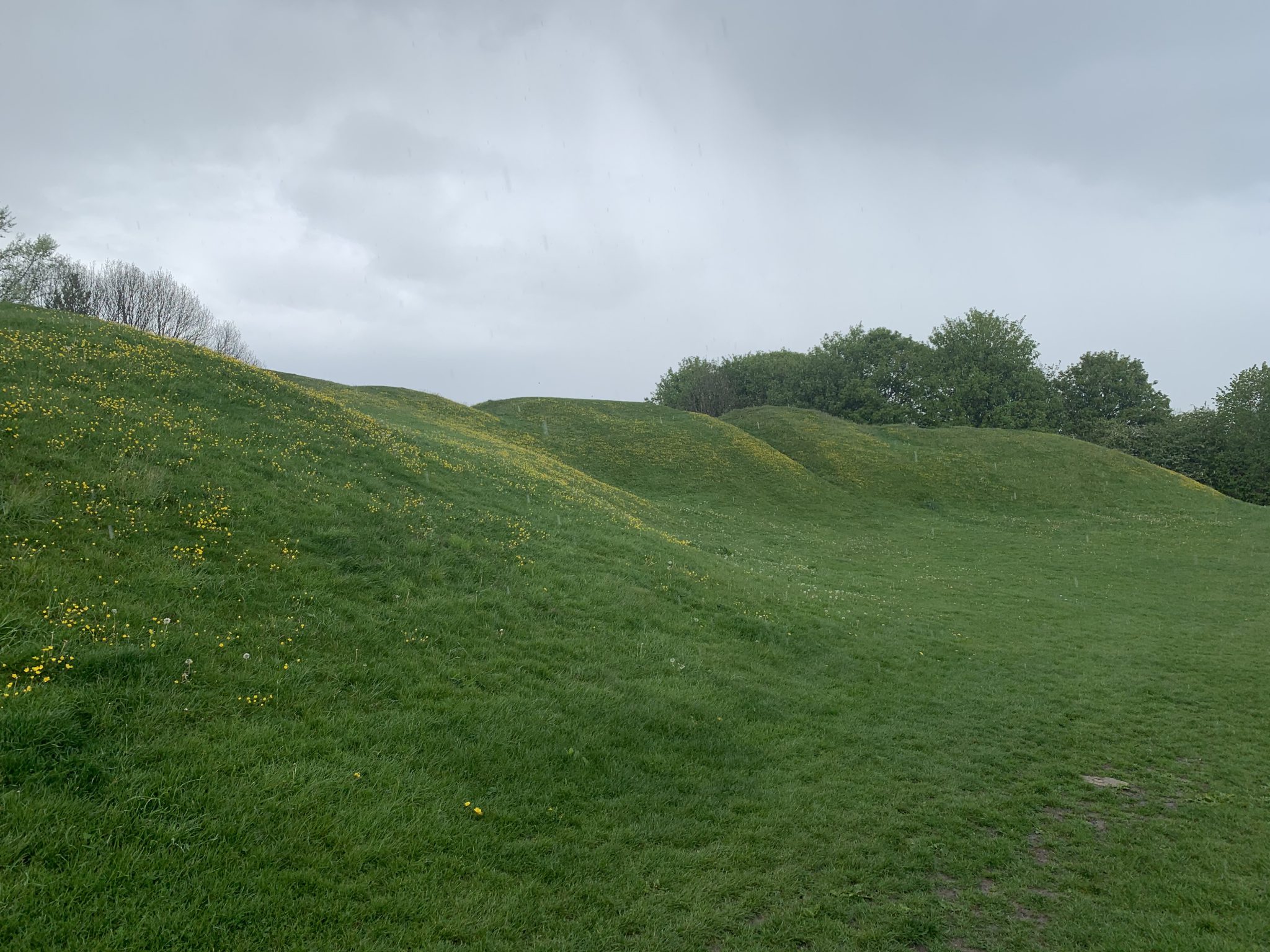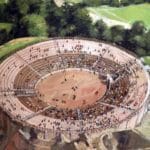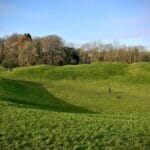Discover Cirencester Amphitheatre, a captivating piece of Roman history in England! As the second-largest Roman amphitheatre in Britain (only London’s surpasses it), it offers a remarkable glimpse into gladiatorial combats, public spectacles, and daily Roman life. Its exceptional preservation provides a fascinating window into the past, making it a must-see destination in the Cotswolds. This article will delve into its history, architecture, significance, and current state.
Cirencester’s Roman Legacy: A Journey Through Time
Corinium’s Colosseum: A Giant in the Cotswolds
Imagine the thunderous roar of a crowd of 8,000, the clash of swords, and the excitement of gladiatorial contests and exotic animal hunts! This was the scene at Cirencester Amphitheatre, a testament to the significance of Corinium Dobunnorum (the Roman name for Cirencester) in Roman Britain. The amphitheatre’s impressive dimensions—roughly 150 feet by 135 feet—and its capacity underscore Corinium’s prominent position as the second largest Roman town in Britain, after Londinium (London).
Masterful Engineering: Built to Last (Mostly)
Constructed in the early 2nd century AD, just outside the city walls, this remarkable structure showcases Roman engineering prowess. The tiered seating banks, originally built from a mixture of earth and timber, rose approximately 25 feet above the arena. While much of the original stonework has been repurposed over centuries, the surviving earthworks offer a powerful and evocative reminder of this ancient spectacle.
Unearthing Secrets: Whispers from the Past
Archaeological excavations at the Cirencester Amphitheatre have yielded fascinating insights into the lives of Corinium’s inhabitants. Discoveries strongly suggest a range of performances took place, including gladiatorial combats, wild animal hunts, and theatrical productions. The seating arrangement likely reflected the social hierarchy of the time, with the most prominent citizens occupying the best seats. Ongoing research continues to reveal further details about the amphitheatre’s usage and the daily lives of those who attended these events; many secrets are probably yet to be unearthed!
Safeguarding History: Keeping the Past Alive
Today, the Cirencester Amphitheatre is meticulously preserved by organizations like English Heritage. These efforts ensure the site’s continued accessibility for visitors and its protection for future generations. The preservation efforts also allow for ongoing archaeological investigation, revealing new information and a deeper understanding of the site. Who knows what future discoveries might further illuminate Cirencester’s Roman past? Visitors are encouraged to check the official website for updated opening times and accessibility information.
Plan Your Visit: A Guide for Travelers
Here’s what you need to know before visiting the Cirencester Amphitheatre:
| Feature | Details |
|---|---|
| Location | Cirencester, Gloucestershire |
| Opening Times | Check the official website for the most up-to-date information. |
| Accessibility | Largely accessible, but check the website for specific details to ensure it meets your needs. |
| Nearby Attractions | Many other historical sites and activities are available nearby! |
| Guided Tours | Inquire about guided tours—they can greatly enhance your experience. |
More Than Ruins: A Window into a Vibrant Past
The Cirencester Amphitheatre is far more than just ancient ruins; it’s a tangible link to the past. It allows us to vividly imagine the lives of the people who once filled its seats, sparking the imagination and offering a profound connection to a pivotal period in British history. Its enduring appeal and ongoing research solidify its position as an invaluable historical site, connecting us to an exciting chapter in Britain’s rich history.
What Did the Romans Call Cirencester?
The Romans knew Cirencester as Corinium Dobunnorum. This name holds clues to its history and the lives of its inhabitants during Roman rule.
Decoding Corinium Dobunnorum: Unraveling the Name
“Dobunnorum” clearly refers to the Dobunni, a Celtic tribe inhabiting the region before the Roman conquest. The origin of “Corinium,” however, remains somewhat mysterious. Some experts believe it may be a Roman-given name, while others suggest a Romanized version of a pre-existing Celtic name. This uncertainty highlights the ongoing complexities of historical research. Further research may shed light on the definitive meaning of this part of the name.
Regardless of its etymology, Corinium Dobunnorum flourished as a major Roman city, second only in size to Londinium (London). Evidence suggests a population that likely exceeded 10,000, creating a vibrant urban center.
The Amphitheatre: A Spectacle of Roman Power
The amphitheatre itself serves as a powerful symbol of Corinium Dobunnorum’s prominence. Its immense size, the sheer capacity of 8,000 spectators, and the visible earthworks clearly demonstrate the importance of public spectacles in Roman society. It wasn’t simply entertainment; these events underscored Roman authority and the town’s status within the Empire.
Daily Life in Corinium: Beyond the Gladiatorial Games
Archaeological findings offer glimpses into the everyday lives of Corinium’s citizens. Imagine bustling markets, skilled artisans creating beautiful objects, and families going about their daily routines. The city’s layout, roads, and houses reflect a structured, sophisticated society. Roman citizens, Britons, and others coexisted, creating a diverse and dynamic community. Ongoing research may illuminate further details about their daily lives, beliefs, and social interactions.
Corinium Dobunnorum’s Enduring Legacy
The influence of Corinium Dobunnorum extends far beyond its Roman era. Its legacy continues to shape Cirencester today. The name itself, and the remaining structures like the amphitheatre, serve as physical and symbolic reminders of this rich and layered history, a continuing narrative that spans across centuries.
Key Points:
- Roman name: Corinium Dobunnorum.
- Second largest Roman town: After Londinium (London).
- Amphitheatre: A significant structure for public spectacles highlighting the city’s importance.
- Legacy: Insights into daily Roman life, government, and city planning techniques.
- Strategic location: Its location contributed to its prosperity, attracting diverse groups.
Fascinating Facts about Cirencester: From Roman Roots to Modern Marvel
Cirencester’s story unfolds across centuries, merging Roman origins with its present-day charm. This exploration will reveal interesting facts—from its Roman roots to its modern-day character.
Corinium Dobunnorum: A Roman Powerhouse
As Corinium Dobunnorum, Cirencester reigned as the second-largest city in Roman Britain, after London. Experts suggest a population exceeding 10,000, a significant number for the period. Archaeological digs are uncovering many more details about the city’s scale and layout. This Roman legacy forms the bedrock of Cirencester’s identity.
The Amphitheatre: A Stage for History’s Greatest Spectacles
The Cirencester Amphitheatre stands as a testament to Roman grandeur. Capable of holding an estimated 8,000 spectators, its scale underscores Corinium Dobunnorum’s wealth and significance. Though much of the original stone has been removed, the surviving earthworks offer a captivating outline of this remarkable structure. Its sheer size (approximately 150 feet by 135 feet) illustrates its importance within the Roman world.
Unearthing the Past: Ongoing Archaeological Discoveries
Archaeological research continues to illuminate Cirencester’s Roman past. New discoveries regularly offer compelling insights into the daily lives of its inhabitants, their homes, tools, and beliefs. The ongoing excavations promise further fascinating revelations about the city’s rich history.
A Tapestry of Time: From Roman to Modern
Cirencester’s story extends far beyond its Roman era. Medieval streets and stunning churches add to its historical significance. The town’s evolution seamlessly combines Roman, medieval, and Georgian architectural styles, creating a unique character. The Royal Agricultural University, established in Cirencester, adds to its intellectual and cultural vibrancy – the oldest of its kind in the English speaking world.
Hidden Gems and Local Legends: The Unexpected Side of Cirencester
Beyond the well-known historical sites, Cirencester boasts intriguing local stories and hidden gems. Tales of ghostly encounters at the King’s Head Hotel, or the unusual method for resolving local election ties, add to the town’s unique character. These lesser-known aspects contribute significantly to Cirencester’s charm.
Summary of Key Discoveries:
| Feature | Description | Significance |
|---|---|---|
| Roman Corinium Dobunnorum | Second largest Roman city in Britain. | Demonstrates the scale and influence of Roman settlement in the region. |
| Amphitheatre | Significant structure showcasing Roman construction and engineering. | Highlights the wealth and importance of the Roman town. |
| Ongoing Archaeological Finds | Continuous discoveries enriching our understanding of daily Roman life. | Provides detailed insight into the culture and society of the inhabitants of Corinium. |
| Blend of Historical Periods | Seamless combination of Roman, Medieval, and Georgian architecture. | Shows the town’s continuous development and evolution over centuries. |
| Unique Local Traditions | Quirky local stories and legends adding character and intrigue to Cirencester. | Adds a layer of human interest and local flavor to the town’s history. |
Cirencester offers a captivating journey through time, blending its rich history with contemporary life. It’s a town that continues to fascinate and inspire.
Is Cirencester a Nice Town to Visit?
The answer, unequivocally, is yes! Cirencester offers a delightful blend of historical charm and modern amenities, creating a captivating experience for visitors.
Roman Echoes in a Modern Setting
Stepping into Cirencester is like stepping back in time, thanks to its well-preserved Roman heritage. The magnificent amphitheatre, the second largest in Britain, serves as a powerful reminder of the city’s Roman past, Corinium Dobunnorum. You can expand your understanding of this period by visiting the Corinium Museum, which houses an impressive collection of Roman artifacts unearthed in the area.
Beyond the History Books: Modern Cirencester
But Cirencester isn’t just about history—it’s a vibrant market town. The market square offers picturesque surroundings and a charming setting, filled with inviting cafes and charming shops. Cirencester Park and Abbey Grounds provide beautiful green spaces perfect for relaxation or a stroll. The prestigious Royal Agricultural University adds to the unique atmosphere of this thriving community.
Something for Everyone: Activities and Attractions
Cirencester caters to diverse interests. History buffs will be enthralled by its Roman ruins and medieval architecture. Nature lovers can enjoy the town’s green spaces, while shoppers will delight in the unique boutiques and shops. A wide range of culinary options, from traditional pubs to fine dining establishments, are available. Families will find plenty to keep children amused, too.
Practical Considerations: Getting Around and Accommodation
Cirencester is easily navigable, and the majority of its attractions are within walking distance. A good public transportation system is in place, and car parking is available. Accommodation ranges from budget-friendly bed and breakfasts to luxury hotels.
Addressing Cost Concerns
While costs can vary, many affordable options are available for accommodation, dining, and activities. Consider visiting during the off-season to potentially reduce costs and avoid large crowds.
What Makes Cirencester Special:
| Feature | Description |
|---|---|
| History | Rich Roman heritage and well-preserved medieval architecture. |
| Activities | Diverse range: historical sites, shopping, parks, restaurants, and pubs. |
| Atmosphere | Peaceful and tranquil, yet lively, particularly in the market square. |
| Practicalities | Easily navigable; diverse accommodation options to suit all budgets. |
In short, Cirencester offers a memorable blend of history and modern charm, making it a truly captivating destination that will likely leave you wanting more.
- Discover Long Black Pepper: Flavor & Health Benefits - April 25, 2025
- Shocking Twists: The Grownup Review: Unreliable Narration - April 25, 2025
- A Quiet Place Book vs Movie: A Deep Dive - April 25, 2025
















